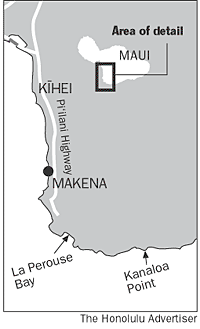By Timothy Hurley
Advertiser Maui County Bureau
U.S. Rep. Patsy Mink has asked the National Park Service to study the feasibility of creating a national park along six miles of rugged Maui coastline from La Perouse Bay to Kanaloa Point.
"This is a site of national significance which deserves the level of protection only the National Park Service can provide," Mink (D-Hawai‘i) wrote in a letter this month to Denis Galvin, the agency’s acting director.
But ordering up such a study may not be so simple. A parks service spokeswoman said that while the agency has the discretion to conduct "a general reconnaissance study" costing less than $25,000, a more comprehensive feasibility study may be needed for something as significant as a potential national park.
"For that, it would have to be authorized by Congress," said Elaine Sevy, National Parks Service public affairs specialist.
The idea to establish a national park in the remote region south of Makena has been endorsed by the Maui County Council and the county Cultural Resources Commission.
Once home to a thriving Native Hawaiian population, the area is now dotted by archaeological sites, including remnants of dwellings, heiau, fishing shrines, platforms, enclosures, shelters, walls, graves and canoe hale that date back to about 1100 A.D.
The region, much of it rugged lava lands owned by the state, is also home to unique native plants and animals, some of which are endangered, and the coast features pristine waters frequented by dolphins and a variety of marine life.
The once-isolated La Perouse Bay, or Keone‘o‘io, has drawn attention with the growth of South Maui and a paved road into the area. Today, hundreds of visitors venture there each day to hike, snorkel and explore.
Mink said that while state officials have expressed interest in managing and protecting the area’s resources, they have been unable to do so for lack of money. Meanwhile, the operators of off-road vehicles are unknowingly destroying sites because of lack of supervision, signs and cultural interpretation materials, she said.
Designation as a national park fits within the National Park Service’s mission of preserving natural and cultural treasures for the enjoyment, education and inspiration of future generations, Mink said.
Mary Evanson, president of the Friends of Haleakala National Park, has been leading a community drive to create the new preserve, with support from the Sierra Club. She said Mink’s involvement is a significant step toward the goal.
Evanson is confident a feasibility study will show the region has all the makings of a national park.
According to the park service, an area is suitable for the national park system if it represents a natural or cultural theme or a type of recreational resource not already adequately represented in the system.
Hawai‘i has two national parks: Haleakala on Maui and Hawai‘i Volcanoes on the Big Island.
The state has five other sites administered by the National Park Service. They are Kaloko-Honokohau National Historical Park, Pu‘uhonua o Honaunau National Historical Park, Pu‘ukohola Heiau National Historic Site, Kalaupapa National Historical Park and the USS Arizona Memorial. The five are not considered national parks.
To be deemed acceptable as a national park unit, an area must be of sufficient size and configuration to ensure long-term resource protection and accommodate public use, and have the potential for management at a reasonable cost, the agency said. A feasibility study must consider land ownership, acquisition costs, access, threats to the resource and staffing.
Most areas end up being rejected by such studies. They either find that they do not pass the test of national significance or that the region receives adequate preservation from another public or private group. The park service said some 175 new area studies were conducted by the agency from 1970 to 1990, with only about 25 percent becoming new national park units.
Congress, however, has established a number of new park areas without benefit of studies or input from the National Park Service, many of them first declared national monuments by a president and then receiving designation from Congress.
Correction: While Haleakala and Hawai‘i Volcanoes are classified as the only two national parks in Hawai‘i, the state has five other sites administered by the National Park Service. They are Kaloko-Honokohau National Historical Park, Pu‘uhonua o Honaunau National Historical Park, Pu‘ukohola Heiau National Historic Site, Kalaupapa National Historical Park and the USS Arizona Memorial. The five are not considered national parks.
[back to top] |

